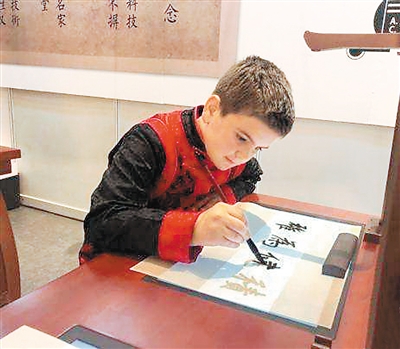


Visitors at the exhibition of new technologies applications and the exhibition of resources for Chinese language teaching at the 13th Confucius Institute Conference try Chinese calligraphy within the exhibits. (Photo/He Shaoqing)
With a slight touch on the two Chinese characters “Anhui”, pictures of Anhui-style buildings appeared on the screen with background music featuring the typical local drama Huangmei Opera, and once you form a correct Chinese four-character idiom using the characters on the screen, you get to enter the next level of the game…
During the 13th Confucius Institute Conference recently concluded in Chengdu, the capital of southwest China’s Sichuan Province, several scientific and technological products showcased at the exhibition of new technologies applications and at the exhibition of resources for Chinese language teaching aroused considerable interest.
In the temporary classroom created by Confucius Institute Headquarters and Tomorrow Advancing Life (TAL), a Chinese education and technology company, a teacher and a cartoon figure named Chuan Chuan took people on a tour of Chengdu by means of the big screen in the classroom.
This classroom was customized for the teaching of Chinese language in Confucius Institutes, said Wan Yiting, vice president of TAL, explaining that with the help of artificial intelligence (AI) technologies such as facial recognition and speech synthesis, it is possible to teach Chinese language in a human-computer interactive manner within the classroom.
“The application of the technologies in Chinese language teaching is mainly intended to tackle such problems in the teaching of Chinese language as a foreign language in a way that solves the uneven distribution of educational resources as well as the shortage of teachers,” said Wan.
Wan added that the AI classroom can stimulate students’ interest in learning Chinese language, reduce the cost of teaching, and particularly make it possible for Chinese language learners all over the world to receive the similar teaching of Chinese language without geographical limitation.
In the experience areas of the exhibition of the applications of new technologies and the exhibition of resources for Chinese language teaching, after people scanned with their phones the cardboard-made images of the characters in Chinese traditional culture including the Door God, the God of Wealth, and the Chinese moon goddess “Chang’e”, these characters became 3-dimensional (3D) cartoon images and started to tell stories of Chinese traditional festivals.
“This is a set of cultural products that seem like simple festival cards but will turn into lively 3D cartoon images with voices once you scan them via an app,” said Ma Xiaofei, deputy general manager of a Chinese education company that developed these products.
According to Ma, this set of products is now able to provide people with knowledge about Chinese traditional culture in five languages including Chinese, English, Russian, Spanish, and Thai.
Beside the set of cardboard-made images there was another product - a language service app named PopOn, which can connect to the native speakers of the languages.
PopOn can provide resources of native speakers of multiple languages such as Chinese, English, Spanish, and Japanese, said Wu Siwen, business development manager of WORDOOR Technology Co., Ltd, the developer of PopOn.
“With just one touch on the key, you will be connected to the global native speakers within 30 seconds,” expressed Wu, adding that the product has so far covered over 1,200 cities in more than 100 countries and regions around the world.
Industry insiders expressed that the applications of AI technologies and speech technologies in education is helpful in expanding the approaches to language learning and promoting innovation in teaching methods, such as integrating these technologies into such processes as the selection of contents of courses, teaching, test and evaluation, data collection, and recommendation of individualized learning programs.
 Fire brigade in Shanghai holds group wedding
Fire brigade in Shanghai holds group wedding Tourists enjoy ice sculptures in Datan Town, north China
Tourists enjoy ice sculptures in Datan Town, north China Sunset scenery of Dayan Pagoda in Xi'an
Sunset scenery of Dayan Pagoda in Xi'an Tourists have fun at scenic spot in Nanlong Town, NW China
Tourists have fun at scenic spot in Nanlong Town, NW China Harbin attracts tourists by making best use of ice in winter
Harbin attracts tourists by making best use of ice in winter In pics: FIS Alpine Ski Women's World Cup Slalom
In pics: FIS Alpine Ski Women's World Cup Slalom Black-necked cranes rest at reservoir in Lhunzhub County, Lhasa
Black-necked cranes rest at reservoir in Lhunzhub County, Lhasa China's FAST telescope will be available to foreign scientists in April
China's FAST telescope will be available to foreign scientists in April "She power" plays indispensable role in poverty alleviation
"She power" plays indispensable role in poverty alleviation Top 10 world news events of People's Daily in 2020
Top 10 world news events of People's Daily in 2020 Top 10 China news events of People's Daily in 2020
Top 10 China news events of People's Daily in 2020 Top 10 media buzzwords of 2020
Top 10 media buzzwords of 2020 Year-ender:10 major tourism stories of 2020
Year-ender:10 major tourism stories of 2020 No interference in Venezuelan issues
No interference in Venezuelan issues
 Biz prepares for trade spat
Biz prepares for trade spat
 Broadcasting Continent
Broadcasting Continent Australia wins Chinese CEOs as US loses
Australia wins Chinese CEOs as US loses